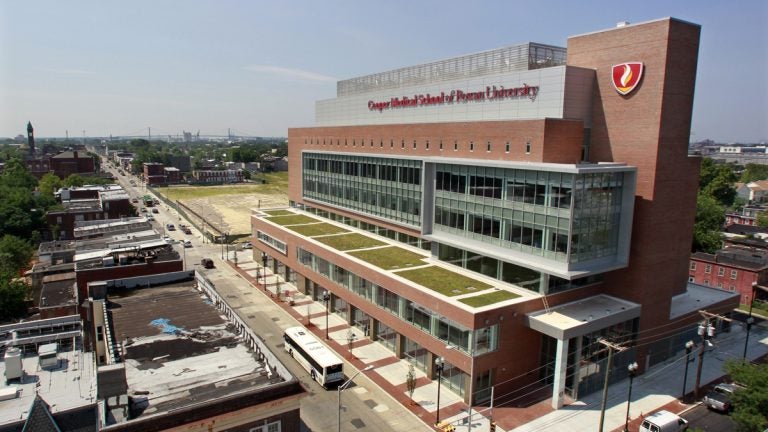Understanding the governing structure for the Rowan/Rutgers eds & meds partnership

Cooper Medical School of Rowan University in Camden. (AP Photo/Mel Evans)
As the past two years have amply demonstrated, nothing is simple when it comes to the realignment of New Jersey’s public institutions of higher education. The University of Medicine and Dentistry of New Jersey was disbanded and split up between Rutgers and Rowan universities.
Of most significance, at least for now, is the long-anticipated joint board of governors established to oversee collaborative health-sciences projects between Rowan University and Rutgers University – Camden (RUC). This joint entity has held its first — mostly procedural — meeting earlier this month. Now, its members are turning to the main task at hand: transforming Camden and its environs into an educational and medical juggernaut.
Rowan University/Rutgers-Camden Board of Governors
The Rowan University/Rutgers-Camden board of governors is the result of a compromise law signed in 2012 that preserved the Camden campus as part of Rutgers but established formal ties between it and Rowan, located 20 miles away in Glassboro.
This new board provides joint oversight for any new health-sciences programs created by either institution or both institutions collaboratively.
Those who defended RUC against efforts to wholly subsume it into Rowan are pleased that at least one member of the joint board is a staunch Rutgers advocate. Still, they wonder if the board and its chairman wield too much power to make unilateral decisions for the constituent schools and the city.
Using $2.5 million allocated annually by each university, the board is charged with founding a College of Health Sciences that will not award its own degrees but will serve as an umbrella for degree-granting programs at each school. It will also house projects that draw faculty, students and professionals from both universities, as well as Camden’s Cooper University Health Care system.
According to a Rowan spokesperson, board members will likely turn their initial attention to Rowan graduate programs in the allied health fields. They are also expected to get involved in population and public health studies, as well as projects that emerge from RUC’s Center for Computational and Integrative Biology and its planned nursing school.
It’s not hard to understand why members of the joint board may be uneasy about the amount of power the board has, as well as the authority ceded to its chair.
At the first board meeting last week, the governors passed a resolution that gives newly elected chair Jack Collins — a former Republican assembly speaker from Salem County — the authority to green-light projects and spending without approval. This decision comes on the heels of a law Gov. Chris Christie quietly signed in January that grants Rowan the power of eminent domain, an ability Rutgers does not have.
A few weeks ago, Rowan’s board of trustees authorized additional funding to seize a home behind the Cooper Medical School of Rowan University, located in downtown Camden, to build parking lots and a delivery area. Rowan Director of Communications Joe Cardona says owners of the remaining 21 lots sold voluntarily and that the university didn’t have to prove blight.
“As a public entity you have to show that there’s a use that’s of a greater good,” he said. “We need the property as part of the medical school. That whole area is expanding.”
The aggressive move, combined with the joint board’s concentration of power and its chairman’s authority are part of what makes some onlookers nervous. Collins, a former Rowan professor and an alumnus of both Rowan and RUC, was appointed to the board by Christie. Also named to the board was Cooper chief of staff Louis Bezich, who was elected vice president. Bezich works for Cooper Chairman George Norcross, a Democratic powerbroker and Christie ally who is believed to have initially urged the governor to recommend the full Rowan-RUC merger.
Norcross holds tremendous influence over Democratic politics in South Jersey, as well as daily dealings in Camden. He helped orchestrate the creation of the Cooper/Rowan med school after he unsuccessfully courted Rutgers.
In addition to Collins and Bezich, the board comprises five more members, four of whom could be viewed as potentially sympathetic to Norcross: Christie appointee Michellene Davis; Rowan designees Chad Bruner and Fred Graziano; Camden Mayor and Norcross teammate Dana Redd; and Robert Mortensen, a Rutgers trustee who fought for RUC when others sought its abolition.
Mortensen is the only member of the joint board of governors without public ties to Norcross or Rowan, and it is he who questioned Collins at the meeting about the resolution to give him unchecked power over financial and project decisions. Although Collins assured board members that he intends to ask them to review all major decisions about hiring, leasing, and purchasing, the resolution and the appointments does raise the question: can Norcross or Christie or both use the board to do their bidding?
George Norcross declined to comment for this story.
___________________________________________
NJ Spotlight, an independent online news service on issues critical to New Jersey, makes its in-depth reporting available to NewsWorks.
WHYY is your source for fact-based, in-depth journalism and information. As a nonprofit organization, we rely on financial support from readers like you. Please give today.




